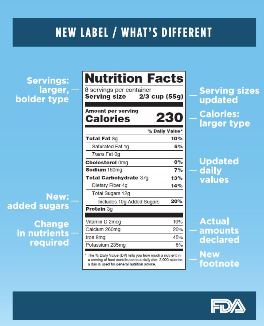FDA Updates Nutrition Labels for Most Packaged Foods
The new label is an updated design highlighting calories and servings, with requirements for serving sizes that more closely reflect the amounts of food that Americans currently eat, according to FDA.
The U.S. Food and Drug Administration on May 20 took what it called "a major step" to ensure consumers have updated nutritional information for most packaged foods sold in the United States, by updating the nutritional labels on their packaging.
 "For more than 20 years, Americans have relied on the Nutrition Facts label as a leading source of information regarding calories, fat, and other nutrients to help them understand more about the foods they eat in a day," said FDA Commissioner Dr. Robert Califf, M.D. "The updated label makes improvements to this valuable resource so consumers can make more informed food choices – one of the most important steps a person can take to reduce the risk of heart disease and obesity."
"For more than 20 years, Americans have relied on the Nutrition Facts label as a leading source of information regarding calories, fat, and other nutrients to help them understand more about the foods they eat in a day," said FDA Commissioner Dr. Robert Califf, M.D. "The updated label makes improvements to this valuable resource so consumers can make more informed food choices – one of the most important steps a person can take to reduce the risk of heart disease and obesity."
The new label is an updated design highlighting calories and servings, with requirements for serving sizes that more closely reflect the amounts of food that Americans currently eat, according to FDA, which confirms that what and how much people eat and drink has changed since the last serving size requirements were published in 1993. The Nutrition Labeling and Education Act that serving sizes be based on what people actually eat.
Also on the new label:
- Declaration of grams and a percent daily value (%DV) for "added sugars" to help consumers know how much sugar has been added to the product.
- "Dual column" labels to indicate both per serving and per package calorie and nutrition information for certain multi-serving food products that could be consumed in one sitting or multiple sittings. Examples are a pint of ice cream and a 3-ounce bag of chips.
- For packages that are between one and two servings, such as a 20-ounce soda, the calories and other nutrients will be required to be labeled as one serving because people typically consume it in one sitting.
- Updated daily values for nutrients such as sodium, dietary fiber, and vitamin D, consistent with Institute of Medicine recommendations and the 2015-2020 Dietary Guidelines for Americans.
- Declaration of Vitamin D and potassium that will include the actual gram amount in addition to the %DV. Some Americans aren't getting enough of these, which puts them at higher risk for chronic diseases.
- "Calories from Fat" will be removed because research shows the type of fat is more important than the amount. "Total Fat," "Saturated Fat," and "Trans Fat" will continue to be required.
- An abbreviated footnote will better explain the %DV.
FDA is also making minor changes to the Supplement Facts label found on dietary supplements to make it consistent with the new label.